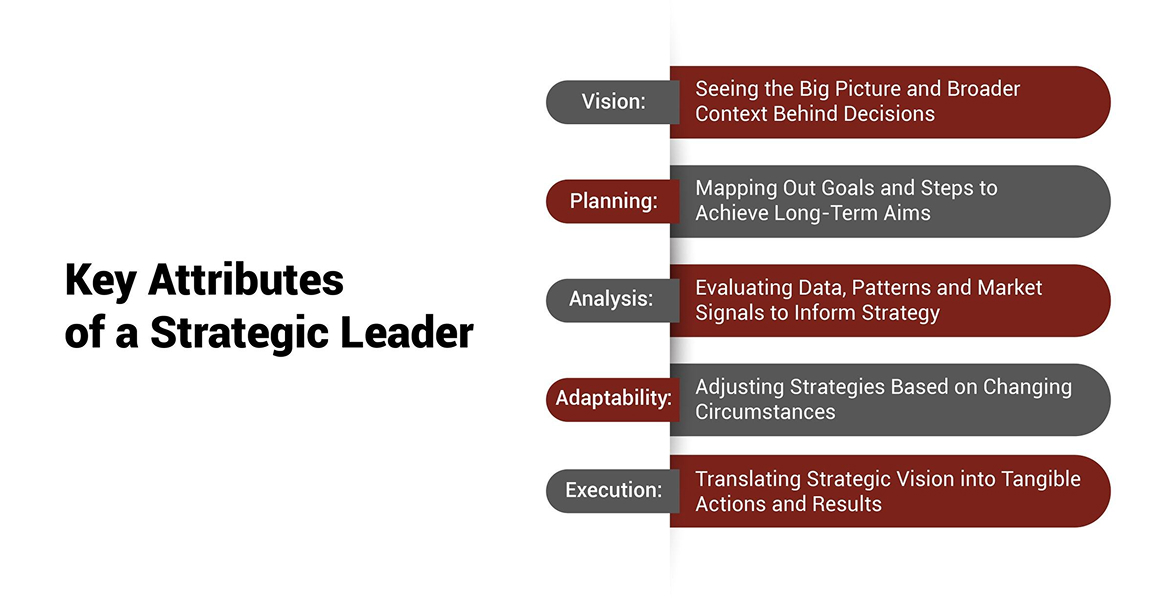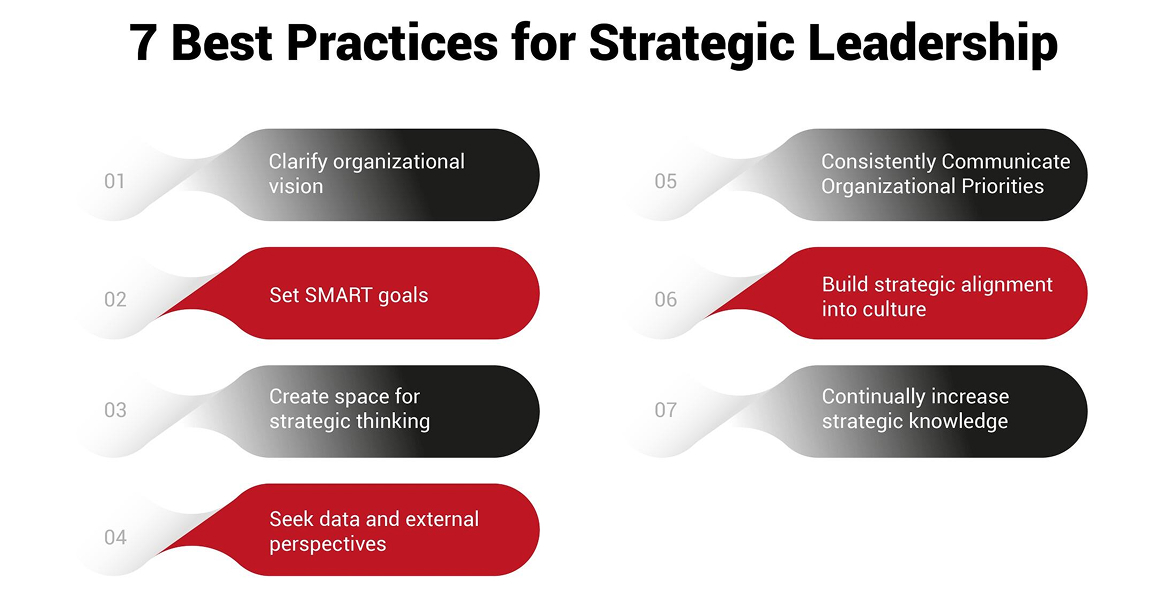Being strategic is about making connections, anticipating challenges, and envisioning future scenarios. It entails adopting both a mindset and skills that empower leaders to transform visions into reality.
Yet for many professionals, “being strategic” feels ambiguous and difficult to pin down concretely. What tangible steps can you take to ensure you are thinking and acting strategically?
This article provides 7 tips and best practices for leaders to cultivate strategic thinking, supporting long-term growth and organizational success.
Before diving into the tips, let’s level-set on what strategic thinking truly means.
Strategic thinking goes beyond short-term wins and planning. It's about taking a comprehensive, long-term view to decision-making and problem-solving.
The Key Attributes of a Strategic Leader:

A defining attribute of effective strategic leaders is the ability to create and clearly communicate an inspiring vision for the future of the organization. This requires seeing the big picture - having a broad perspective and understanding how various internal and external factors influence the organization and its strategy.
Strategic leaders envision not just what the organization is today, but what it could become in the future. They imagine an ambitious yet achievable ideal state that provides direction, ignites passion in employees, and helps differentiate the organization from competitors.
Developing this vision requires strong analytical skills to thoroughly assess the current reality and determine what must change to reach the future state. Strategic leaders analyze trends, market forces, innovations, and opportunities that will shape and impact the competitive landscape. This analysis allows leaders to make decisions anchored in a keen awareness of the broader context, rather than having a narrow short-term focus.
Bringing a wide lens also enables strategic leaders to see interconnections between different units and stakeholders within and outside the organization. They can then craft an integrated vision and strategy that aligns various groups, brings cohesion, and mobilizes joint action toward achieving that vision.
While vision provides the “what” of leadership strategy, planning entails mapping out the “how” - figuring out how to make the vision a reality given constraints. Effective strategic leaders excel at planning by setting long-term macro goals and designing roadmaps to coordinate resources and activities.
Unlike tactical planning focused on short-term targets, strategic planning requires adopting longer time horizons to fulfill bigger, bolder ambitions. Leaders carry out environmental scans, conduct risk analyses, align budgets, create milestones and action steps spanning years, and develop contingency plans to navigate uncertainty. This long-range planning steers organizational decisions and operations towards the intended vision.
Moreover, strategic leaders involve others in co-creating strategy, plans, and execution measures. By working collaboratively with teams instead of handing down rigid prescriptive plans, leaders can leverage diverse insights to strengthen strategies. Teams also feel greater ownership over bringing shared plans to fruition.
In today’s complex, fast-changing world, strategy involves continual learning and adjustment as conditions evolve. While having clearly defined goals and plans is essential, strategic leaders balance this with flexibility to pivot as market needs shift. An adaptive planning mindset keeps the organization dynamically moving towards the vision.
Strategic leaders rely extensively on evidence-based analysis to diagnose the current state, identify opportunities for improvement, and evaluate progress. Whether using financial metrics, customer data, industry benchmarking, or operational analytics, analysis crucially informs major strategic decisions and interventions.
For instance, leaders analyze customer and sales data to determine market gaps, pinpoint new business opportunities, tailor product/service strategies, and allocate resources. Competitive analysis of rival offerings, pricing, and activities also shapes strategic positioning and decisions. Leaders additionally assess metrics on internal capabilities to guide capability-building initiatives like upskilling talent or adopting new technologies.
Ongoing analysis provides strategic leaders the situational awareness to know when and how to adjust course towards the intended vision and goals. Rather than relying on hunches or anecdotes, data-savvy strategic leaders ground strategy formulation and execution in robust analytics.
Volatility stemming from things like technological disruptions, customer shifts, regulations, supply chain shocks, and competitive turbulence means change is a constant for modern organizations. Strategic leaders thus require the nimbleness to update strategies and realign operations with emerging realities so the organization stays relevant.
This means monitoring leading indicators and having trigger points that signal when circumstances have sufficiently changed to warrant revisiting assumptions, priorities, and activities. Rather than rigidly sticking to potentially outdated plans, strategic leaders continually scan the horizon for obstacles and openings. A learning mindset also supports testing new approaches to drive innovation and evolution.
Leading adaptively further entails mitigating the human side of change. Strategic leaders exhibit empathy when communicating changes in vision or plans, understanding such pivots spur uncertainty. Providing transparency into why shifts are happening along with evidence builds buy-in. And crucially supporting people through transitions accelerates adopting revisions.
Ultimately, in dynamic environments strategic leaders see adaptability not as wavering on direction but rather as intentionally steering towards the vision while accounting for real-time developments. This agility based on external vigilance and internal support sustains progress.
The final indispensable ability for strategic leaders is execution - turning strategic thinking and planning into concrete results. A compelling vision and sound plans fundamentally rely on coordinated organizational-wide execution across units, functions, and individual contributors.
Leaders mobilize execution by ensuring strategy gets translated into specific measurable goals and key performance indicators (KPIs) that cascade from the executive level down to frontline teams. This strategic alignment of objectives at scale provides focus and clarity on how all employees directly contribute to realizing high-level strategy through their day-to-day work.
Ongoing performance monitoring through robust analytics and dialogue further enables the agility to adjust execution processes to better align outputs and outcomes with intended goals. By proactively identifying execution gaps – whether stemming from capability deficiencies or planning oversights – leaders can course correct quickly, not when lagging results confirm breakdowns after the fact.
Creating infrastructure like streamlined decision rights, collaborative structures, and enabling technology systems also boosts owning and nailing execution. So does pushing authority to those closest to the work who best grasp operational nuances so challenges get solved rapidly.
Finally, strategic leaders motivate execution excellence by connecting teams to the inspirational “why” behind strategic aims. Communicating a compelling purpose activates intrinsic motivation and bought-in commitment to excel in making the strategy real through world-class execution. This leadership support sustains the perseverance to translate big visions into tangible performance wins.
By developing these competencies, leaders can enhance their abilities to think, act, and influence outcomes strategically.
Strategic leadership is critical for organizations seeking to thrive in today's fast-paced and constantly evolving business landscape. Mastering strategic leadership unlocks a range of benefits that facilitate enduring success despite uncertainty and chaos. There are several key reasons why strategic leadership matters so much:
Rather than rely solely on past templates or norms, strategic leaders take a creative, future-focused approach to decision-making. They imagine multiple future scenarios, anticipating changes and challenges that could impact the business. With this understanding, they are able to make informed choices that set up the organization for long-term growth and sustainability. Even amidst uncertainty and chaos, strategic leaders use foresight and analysis to position the company to capitalize on emerging opportunities.
Effective strategic leaders don't just set the course, they mobilize action towards realizing the vision. Once the roadmap is clear, they waste no time in beginning to execute, moving with the speed of change rather than getting left behind by market transitions. As new challenges emerge, they adapt tactics while keeping focus on the north star. Strategic leaders also ensure alignment, directing resources and efforts toward strategic priorities rather than getting distracted by less critical initiatives.
One of the most vital roles of a strategic leader is engaging others around a shared vision for the future. They paint a picture of what success looks like while fostering buy-in across the organization. This gives teams at all levels a clear line of sight into how their work ladders up to big-picture goals. Strategic leaders tap into people's intrinsic motivation, building an emotional connection to collective ambition. This inspirational force is the fuel that powers execution excellence.
In short, mastering strategic leadership allows you to shape your organization’s vision, communicate it effectively, and lead successful execution.
Now let’s explore 7 tips and best practices to help cultivate your strategic leadership.

Having a clear strategic vision is foundational. As a leader, constantly communicate how decisions ladder up to serving the broader organizational vision. This grounds teams in shared purpose and priorities.
Set aside time to re-evaluate vision clarity and alignment across the organization. Are leaders and teams seeing how their efforts map towards big-picture goals? If not, refine communications to tighten strategic alignment.
Well-defined goals enable successful strategy execution. Goals should be Specific, Measurable, Achievable, Relevant and Time-bound (SMART). Frame goals clearly and ensure they align to overarching organizational objectives.
Regularly realign leaders’ and teams’ near-term goals to the longer-term organizational strategy. Consistent alignment drives strategic impact and culture.
Carving out dedicated time for reflection and strategic planning is vital. Block off at least an hour each week to step back and evaluate bigger picture connections, ideas and scenarios related to achieving long-term aims.
Make this time non-negotiable by putting it in your calendar. It’s also critical to build a culture that values strategic thinking across your organization.
Leverage data, research and insights from trusted advisors to inform strategy. Seek external perspectives from mentors, partners and even other industries to expand thinking.
Data and multiple lenses help leaders make calculated decisions aligned to organizational strategy, even amidst uncertainty.
Leaders often underestimate how much communication is needed to convey strategic priorities to teams. Frequent and clear communication ensures everyone understands key objectives and how their roles contribute to them.
Effectively communicate priorities through meetings, presentations, FAQ documents, recaps of decision contexts, and regular reminders of key milestones for the next six months.
Have strategic alignment into your culture. From setting goals during quarterly check-ins to praising employee efforts that clearly map to organizational priorities, underscore strategy alignment.
Publicly highlight teams and projects that advance organizational priorities. Have leaders share how new initiatives align with strategic growth areas.
Commit to continuous learning around strategy, leadership and organizational priorities. Surrounding yourself with strategic thinkers provides inspiration to adapt and enhance how you think and operate.
Read books and blogs from leaders you admire, pursue courses in strategic management, and continually expand and refine strategic approaches over time.
Keep these 7 best practices top of mind as you work towards enhancing strategic thinking and leadership abilities over time.
The cultivation of a strategic mindset is an iterative process requiring consistent effort and growth – but doing so can elevate your leadership impact exponentially.
Prioritize dedicating time each month to pause, reflect and refine strategy. Seek insights from peers and mentors on how to enhance strategic thinking. Measure effectiveness by assessing whether teams connect day-to-day efforts to driving organizational vision and priorities.
Committing to lifelong improvement around strategic leadership ultimately empowers you to maximize value creation and drive enduring success.

CredBadge™ is a proprietary, secure, digital badging platform that provides for seamless authentication and verification of credentials across digital media worldwide.
CredBadge™ powered credentials ensure that professionals can showcase and verify their qualifications and credentials across all digital platforms, and at any time, across the planet.

Keep yourself informed on the latest updates and information about business strategy by subscribing to our newsletter.